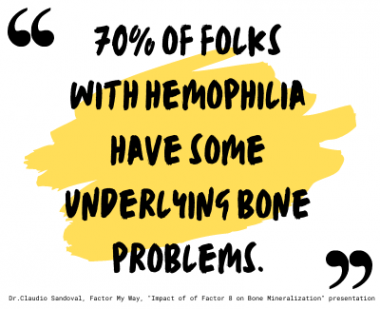How Hemophilia Can Affect Bone Health

I recently attended a webinar called “Impact of Factor 8 on Bone Mineralization,” sponsored by Factor My Way, a patient support program. It featured Claudio Sandoval, MD, who has over 30 years of experience treating people with bleeding disorders and is passionate about bone health, an often overlooked aspect of hemophilia.
Joint disease is a common problem for people with hemophilia A and B due to joint bleeds. When a person with hemophilia bleeds internally into their joint space, the blood causes irritation and inflammation. The joint becomes chronically inflamed and permanently damaged. Sandoval said repeat joint bleeds can feel like having rheumatoid arthritis and osteoarthritis simultaneously. But what about bones?
Impact of factor VIII on bone mineralization
Bone health is essential to quality of life. Now that people with hemophilia are living longer, it’s a crucial topic to address.
Studies have shown that blood clotting factor VIII is essential to developing healthy bones. The lack of functioning factor VIII changes how bone mineralizes, but researchers are unsure why. Because people with hemophilia A, as well as many carriers, are deficient in factor VIII, this can lead to bone problems.
I asked Sandoval if bone health is a concern for people with hemophilia B or von Willebrand disease (VWD). Hemophilia B is also associated with bone defects and low bone density, but because this hemophilia type refers to factor IX deficiency, missing factor VIII is not the culprit. Sandoval said that people with VWD tend to have healthy bones, though more studies of this population are needed.
He explained that a factor VIII deficiency puts everyone with hemophilia A, including female carriers with normal factor levels, at an increased risk of low bone density. This can result in osteopenia and progress to osteoporosis. Osteoporosis is when the bone mineral density becomes so low that bones become weak and brittle, putting you at an increased risk of bone fractures.
Out of 10 people with hemophilia A, four will have osteopenia, and three will have osteoporosis, according to one study that Sandoval quoted.

(Graphic by Jennifer Lynne)
In hemophilia, fractures often occur in one’s 30s, 40s, and 50s. People with bleeding disorders may struggle with healing and even suffer repeat fractures.
Even when people with hemophilia A receive replacement factor VIII, it doesn’t always keep joints and bones healthy. Some people will have silent bleeds or microbleeds, which will show up on an MRI.
Changes to bones and joints occur slowly over time. Sandoval said that we are still learning about the ways factor VIII deficiency affects the body.
Bone health tips from Dr. Sandoval
A primary care physician should quarterback your healthcare team and help guide you through these issues.
People with hemophilia A (and carriers) should get a dual-energy X-ray absorptiometry (DEXA) scan to measure their bone mineral density. DEXA scans are often recommended at puberty, but if you’ve never had one, now is a good time. Depending on the results, you may need medication to help build your bones. Avoiding osteoporosis will contribute to a better quality of life.
Eat a healthy diet full of minimally processed foods that come from the ground. Walking and swimming are excellent forms of exercise. Weight training with light weights will help to strengthen muscles. Yoga is great for stretching. Many exercise videos are available on YouTube and can be followed at home.
If you have joint damage from hemophilia, work with a physical therapist who specializes in bleeding disorders. Focus on stretching or walking in a pool.
I suggest watching Sandoval’s full presentation, which will require you to create a free account on the Factor My Way website.
Sandoval said we are just beginning to understand the roles that factor VIII plays in the body beyond blood clotting. Hopefully, research in this area will lead to better treatments and improve the lives of those affected.
Have you experienced decreased bone density as someone with hemophilia? I would love to hear your experiences and suggestions for maintaining good bone health in the comments below.
Note: Hemophilia News Today is strictly a news and information website about the disease. It does not provide medical advice, diagnosis, or treatment. This content is not intended to be a substitute for professional medical advice, diagnosis, or treatment. Always seek the advice of your physician or another qualified health provider with any questions you may have regarding a medical condition. Never disregard professional medical advice or delay in seeking it because of something you have read on this website. The opinions expressed in this column are not those of Hemophilia News Today or its parent company, Bionews, and are intended to spark discussion about issues pertaining to hemophilia.








Leave a comment
Fill in the required fields to post. Your email address will not be published.